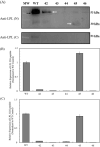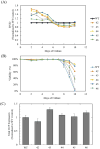Knockout of a difficult-to-remove CHO host cell protein, lipoprotein lipase, for improved polysorbate stability in monoclonal antibody formulations
- PMID: 27943242
- PMCID: PMC5360534
- DOI: 10.1002/bit.26237
Knockout of a difficult-to-remove CHO host cell protein, lipoprotein lipase, for improved polysorbate stability in monoclonal antibody formulations
Abstract
While the majority of host cell protein (HCP) impurities are effectively removed in typical downstream purification processes, a small population of HCPs are particularly challenging. Previous studies have identified HCPs that are challenging for a variety of reasons. Lipoprotein lipase (LPL)-a Chinese hamster ovary (CHO) HCP that functions to hydrolyze esters in triglycerides-was one of ten HCPs identified in previous studies as being susceptible to retention in downstream processing. LPL may degrade polysorbate 80 (PS-80) and polysorbate 20 (PS-20) in final product formulations due to the structural similarity between polysorbates and triglycerides. In this work, recombinant LPL was found to have enzymatic activity against PS-80 and PS-20 in a range of solution conditions that are typical of mAb formulations. LPL knockout CHO cells were created with CRISPR and TALEN technologies and resulting cell culture harvest fluid demonstrated significantly reduced polysorbate degradation without significant impact on cell viability when compared to wild-type samples. Biotechnol. Bioeng. 2017;114: 1006-1015. © 2016 Wiley Periodicals, Inc.
Keywords: CHO cell; CRISPR; host cell protein; lipase; polysorbate.
© 2016 Wiley Periodicals, Inc.
Figures






Similar articles
-
Illuminating a biologics development challenge: systematic characterization of CHO cell-derived hydrolases identified in monoclonal antibody formulations.MAbs. 2024 Jan-Dec;16(1):2375798. doi: 10.1080/19420862.2024.2375798. Epub 2024 Jul 10. MAbs. 2024. PMID: 38984665 Free PMC article.
-
Multi-lipase gene knockdown in Chinese hamster ovary cells using artificial microRNAs to reduce host cell protein mediated polysorbate degradation.Biotechnol Bioeng. 2024 Jan;121(1):329-340. doi: 10.1002/bit.28563. Epub 2023 Sep 25. Biotechnol Bioeng. 2024. PMID: 37743807
-
Without a trace: multiple knockout of CHO host cell hydrolases to prevent polysorbate degradation in biologics.Trends Biotechnol. 2025 Aug;43(8):1982-2002. doi: 10.1016/j.tibtech.2025.04.016. Epub 2025 May 29. Trends Biotechnol. 2025. PMID: 40441922
-
Two major mechanisms contributing to copurification of CHO host cell proteins and strategies to minimize their negative impact.Protein Expr Purif. 2022 Sep;197:106113. doi: 10.1016/j.pep.2022.106113. Epub 2022 May 20. Protein Expr Purif. 2022. PMID: 35598695 Review.
-
Methods for addressing host cell protein impurities in biopharmaceutical product development.Biotechnol J. 2023 Mar;18(3):e2200115. doi: 10.1002/biot.202200115. Epub 2022 Dec 13. Biotechnol J. 2023. PMID: 36427352 Review.
Cited by
-
Insights into ultra-low affinity lipase-antibody noncovalent complex binding mechanisms.MAbs. 2022 Jan-Dec;14(1):2135183. doi: 10.1080/19420862.2022.2135183. MAbs. 2022. PMID: 36284469 Free PMC article.
-
Alternative Excipients for Protein Stabilization in Protein Therapeutics: Overcoming the Limitations of Polysorbates.Pharmaceutics. 2022 Nov 23;14(12):2575. doi: 10.3390/pharmaceutics14122575. Pharmaceutics. 2022. PMID: 36559072 Free PMC article. Review.
-
Using Metabolomics to Identify Cell Line-Independent Indicators of Growth Inhibition for Chinese Hamster Ovary Cell-based Bioprocesses.Metabolites. 2020 May 15;10(5):199. doi: 10.3390/metabo10050199. Metabolites. 2020. PMID: 32429145 Free PMC article.
-
Host cell protein detection gap risk mitigation: quantitative IAC-MS for ELISA antibody reagent coverage determination.MAbs. 2021 Jan-Dec;13(1):1955432. doi: 10.1080/19420862.2021.1955432. MAbs. 2021. PMID: 34347561 Free PMC article.
-
Illuminating a biologics development challenge: systematic characterization of CHO cell-derived hydrolases identified in monoclonal antibody formulations.MAbs. 2024 Jan-Dec;16(1):2375798. doi: 10.1080/19420862.2024.2375798. Epub 2024 Jul 10. MAbs. 2024. PMID: 38984665 Free PMC article.
References
-
- Bobik A. Apolipoprotein CIII and atherosclerosis: beyond effects on lipid metabolism. Circulation. 2008;118:702–704. - PubMed
-
- Brinkrolf K, Rupp O, Laux H, Kollin F, Ernst W, Linke B, Kofler R, Romand S, Hesse F, Budach WE, Galosy S, Muller D, Noll T, Wienberg J, Jostock T, Leonard M, Grillari J, Tauch A, Goesmann A, Helk B, Mott JE, Puhler A, Borth N. Chinese hamster genome sequenced from sorted chromosomes. Nat Biotechnol. 2013;31:694–695. - PubMed
-
- Champion KM, Madden H, Dougherty J, Shacter E. Defining your product profile and maintaining control over it, part 2. Bioprocess Int. 2005;3:52–57.
MeSH terms
Substances
Grants and funding
LinkOut - more resources
Full Text Sources
Other Literature Sources
Research Materials
Miscellaneous

